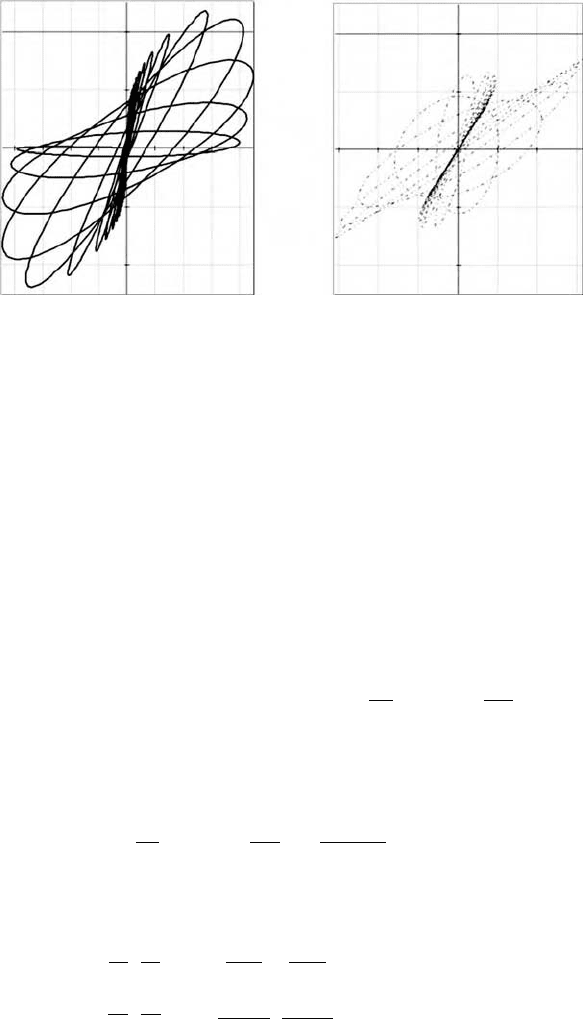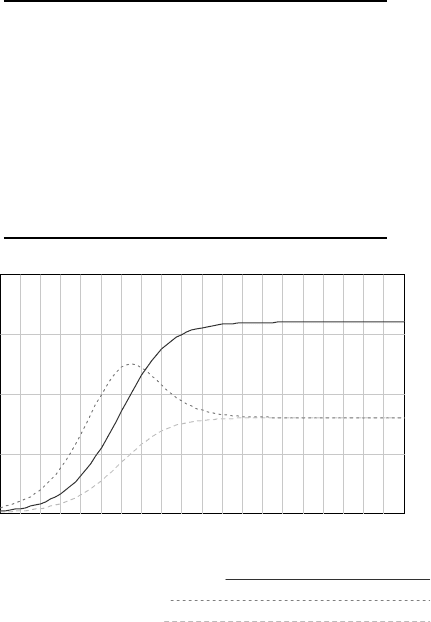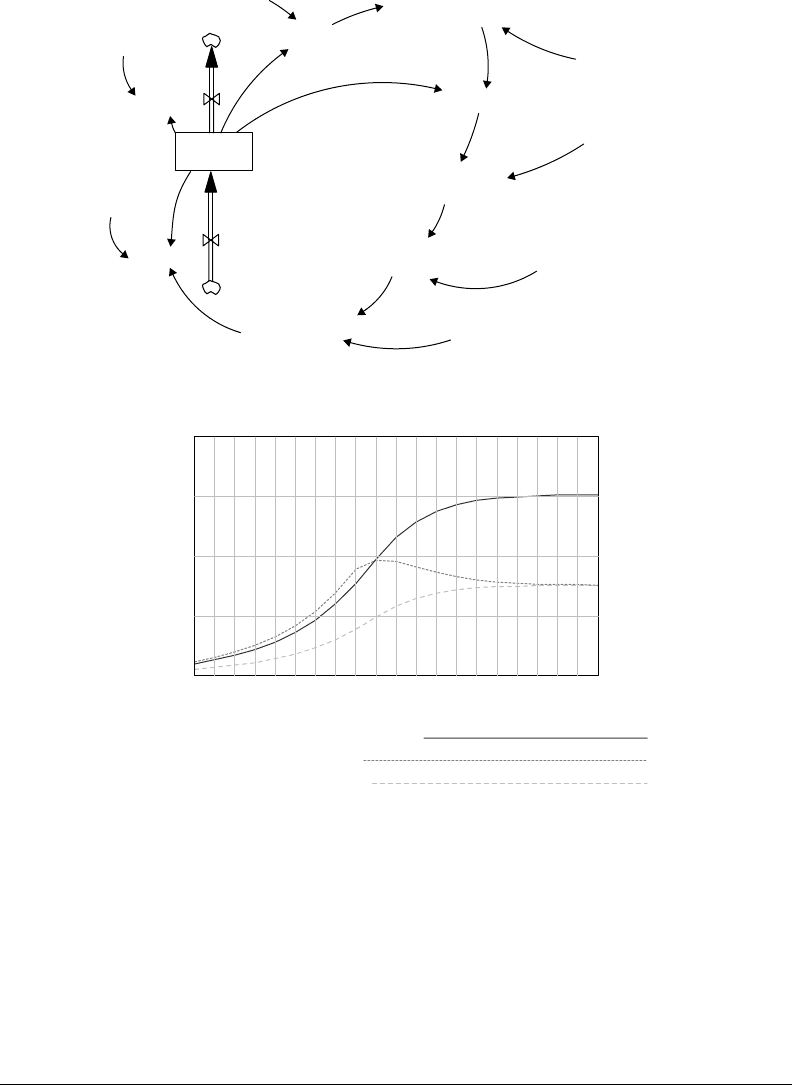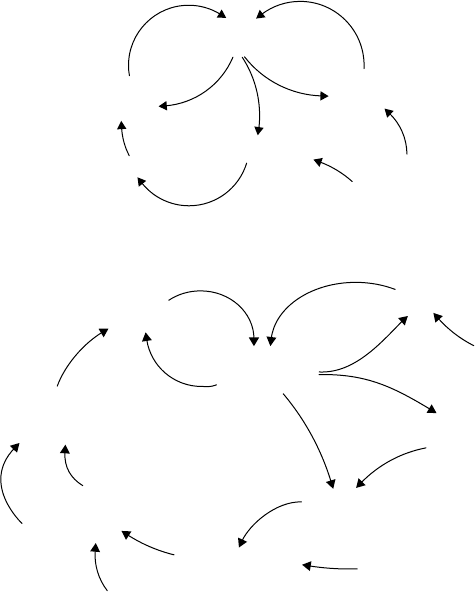Fishwick P.A. (editor) Handbook of Dynamic System Modeling
Подождите немного. Документ загружается.


26-26 Handbook of Dynamic System Modeling
u
i
ii
i
F
V
SGY 0 TF
1
C : L
Kx
C : 1/K
..
⫺nBl
⫺nBlv
dLi/dt
dl/dt
FIGURE 26.25 Addition of elastic cone suspension resulting in the decomposition of a two-port storage element.
which can be written dλ/dt =dLi/dt +nBlv =dLi/dt +nBldx/dt, after integration: λ =Li +nBlx. If this
constitutive relation is put in preferred integral causality i =1/Lλ −(nBl)/(L)x and combined with the
relation of the mechanical port F =−nBli =(−nBl/L)λ +((nBl)
2
/L)x into a relation of a two-port C in
matrix form:
i
F
=
⎡
⎢
⎢
⎣
1
L
−
nBl
L
−
nBl
L
(nBl)
2
L
⎤
⎥
⎥
⎦
λ
x
(26.27)
it can be concluded that this two-port satisfies Maxwell symmetry, but that it is singular
(1/L((nBl)
2
/L) −(−nBl/L)
2
=0), such that a positive mechanical spring constant K representing the
connection to the frame of the moving voice coil, has to be added to make it intrinsically stable:
1/L(((nBl)
2
/L) +K) −(−nBl/L)
2
> 0 (Figure 26.25).
The junction structure with the transformer and the two Cs coincides with the so-called congruent
canonical decomposition of a linear two-port C of which the energy can be used as a generating function
of the constitutive relations (Breedveld, 1984b). When starting again without a mechanical spring, the
energy of this two-port should be written in terms of λ and x:
dE(λ, x) = idλ +Fdx =
λ
L
−
(nBl)x
L
dλ +
−
(nBl)λ
L
+
(nBl)
2
x
L
dx = d
(λ −(nBl)x)
2
2L
such that E(λ, x) =(λ −(nBl)x)
2
/2L, but is commonly mistaken by what is actually the coenergy in terms
of i and x: E
∗
(i, x) =Li
2
/2 +nBlix.
If this is the case and the force is incorrectly derived by taking the partial derivative of this coenergy as
if it were an energy F
incorrect!
= ∂E
∗
(i, x)/∂x =(i
2
/2)dL/dx +nBli, a sign error is obtained, as it should be
F =
∂E(λ, x)
∂x
=
∂
∂x
(λ −(nBl)x)
2
2L
=−(nBl)
λ
L
−
(nBl)x
L
−
1
2
λ
L
−
(nBl)x
L
2
dL
dx
=−(nBl)i −
1
2
i
2
dL
dx
Note that the mere difference in the form of a minus sign between these results only occurs for the
particular case in which the current i depends linearly on the flux linkage λ. In case of a nonlinear relation,
the error is larger than “just” a sign error that is commonly not noticed as it is compensated by an implicit
change in orientation: in contrast with the global convention, the mechanical port is then taken positively
outbound.
If a spring is added to satisfy intrinsic stability the energy increases with the potential energy
E(x) =Kx
2
/2 and similar constitutive relations are found from the energy function:
i
F
=
⎡
⎢
⎢
⎣
∂i
∂λ
∂i
∂x
∂F
∂λ
∂F
∂x
⎤
⎥
⎥
⎦
λ
x
=
⎡
⎢
⎢
⎣
∂
2
E
∂λ
2
∂
2
E
∂x∂λ
∂
2
E
∂λ∂x
∂
2
E
∂x
2
⎤
⎥
⎥
⎦
λ
x
=
⎡
⎢
⎢
⎣
1
L
−
nBl
L
−
nBl
L
(nBl)
2
L
+K
⎤
⎥
⎥
⎦
λ
x
(26.28)

Port-Based Modeling of Engineering Systems in Terms of Bond Graphs 26-27
⫺0.08⫺0.06 0.06
⫺0.2
⫺0.1
0.1
0.2
0
⫺0.04⫺0.02 0.02 0.04 0.080
Mech_state
Mech_effort
Model
(a)
⫺0.15
⫺0.2
⫺0.1
0.1
0.2
0
⫺0.1 ⫺0.05 0.05 0.1 0.150
Magn_state
Magn_effort
Model
(b)
FIGURE 26.26 Simulation of the mechanical and magnetic cycle with frequency sweep input.
which is intrinsically stable as long as (nBl)
2
/L
2
+K/L −(nBl)
2
/L
2
=K/L > 0. Figure 26.26 shows the
simulation results of a loudspeaker model containing this two-port, with a sinusoidal frequency sweep
input at the electric port. Both ports indeed perform a cycle process in which the magnetic port cycles
clockwise and the mechanical port counterclockwise (large loops, i.e., more energy transferred per cycle,
represent a simulation at the resonance frequency of the speaker), which demonstrates that indeed per
cycle a net amount of magnetic (electric) energy is transduced into mechanical energy. The areas of the
loops are equal in the conservative case.
Obviously, if the coenergy is explicitly identified as being different from the energy, the derivations lead
to the correct results too
E
∗
(i, x) =−(E(λ, x) −iλ) = iλ − E(λ, x) =
Li
2
2
+nBlix −
Kx
2
2
(26.29)
dE
∗
(i, x) = λdi − Fdx = Lidi +nBlidx −Kxdx (26.30)
Hence
E
∗
(i, x) =
Li
2
2
+nBlix −
Kx
2
2
λ =
∂E
∗
(i, x)
∂i
= Li +nBlx (26.31)
so u =dλ/dt =d/dt(∂E
∗
(i, x)/∂i) =L(di/dt) +nBlv =u
self ind
+u
Lorentz
and F =−∂E
∗
(i, x)/∂x =
−nBli +Kx, in matrix form:
λ
F
=
⎡
⎢
⎢
⎣
∂λ
∂i
∂λ
∂x
∂F
∂i
∂F
∂x
⎤
⎥
⎥
⎦
=
⎡
⎢
⎢
⎣
∂
2
E
∗
∂i
2
∂
2
E
∗
∂i∂x
−∂
2
E
∗
∂x∂i
−∂
2
E
∗
∂x
2
⎤
⎥
⎥
⎦
=
L nBl
−nBl K
i
x
(26.32)
i.e., no symmetry of the Jacobian if energy and coenergy are confused.
This example demonstrates that the concept of multiport storage, in particular two-port storage, may
not only lead to conceptual models of transduction phenomena, but also that reversible transduction
requires a cycle process in principle. This means that a transducer cannot continuously transduce a DC
input. By changing its configuration into that of an electric motor, the configuration takes care of the cycle
of the conductors in the magnetic field.

26-28 Handbook of Dynamic System Modeling
Hence, pure “DC”-type transduction can only be achieved by some form of “carrier” that performs a
cycle: gears carrying teeth (with elastic deformation!) during contact, a cooling fluid, and a rolling wheel
that cycles its interaction point, which is a useful insight during conceptual design of transducers.
26.5 Conclusion
In this chapter, the basics of the port-based approach were introduced as well as their natural notation,
viz. bond graphs. The main advantages of the use are
(1) the domain-independence of the elementary behaviors and their graphical notation that allow quick
analysis of dynamic interaction across domain boundaries;
(2) that not all ports have an a-priori fixed causality, thus allowing flexible reuse of submodels;
(3) the combination of physical and computational structure in one notation, thus allowing
a. direct physical interpretation of required changes in model structure, e.g., for controller design,
b. direct feedback on modeling decisions,
c. direct graphical input for simulation software.
All these features contribute to rapid insight and the ability of efficient iteration during the modeling
process.
It was also demonstrated that various domains of physics that use some form of energy-based model
formulation technique are all strongly related, even though terminologyand a loss of conceptual distinction
between conserved energy and its nonconserved Legendre transforms commonly obstructs this insight.
References
Ascher, U. M. and Petzold, L. R. 1998. Computer Methods for Ordinary Differential Equations and
Differential-Algebraic Equations. Philadelphia: SIAM.
Bos, A. M. 1986. Modelling Multibody Systems in Terms of Multibond Graphs. Ph.D. Thesis, Electrical
Engineering, University of Twente, Enschede, Netherlands.
Bos, A. M. and Tiernego, M. J. L. 1985. Formula manipulation in the multibond graph modelling and
simulation of large mechanical systems. J. Franklin Inst., Vol. 319, No. 1/2, pp. 51–65.
Breedveld, P. C. 1982. Thermodynamic bond graphs and the problem of thermal inertance. J. Franklin
Inst., Vol. 314, No. 1, pp. 15–40.
Breedveld, P. C. 1984a. Physical Systems Theory in Terms of Bond Graphs. ISBN 90-9000599-4. University
of Twente, Enschede, The Netherlands. Distributed via the author.
Breedveld, P. C. 1984b. Decomposition of multiport elements in a revised multibond graph notation.
J. Franklin Inst., Vol. 318, No. 4, pp. 253–273.
Breedveld, P. C. 1985. Multibond graph elements in physical systems theory. J. Franklin Inst., Vol. 319, No.
1/2, pp. 1–36.
Breedveld, P. C. 1999. Insight in rigid body motion stability via an alternative for the Eurlerian junc-
tion structure. Proceedings 1999 International Conference on Bond Graph Modeling and Simulation
(ICBGM’99), San Francisco, USA, Western Multi Conference Simulation Series, Vol. 31, No. 1, pp.
269–274.
Callen, H. B. 1960. Thermodynamics. New York: Wiley.
Golo, G. 2002. Interconnection Structures in Port-Based Modelling: Tools for Analysis and Simulation. Ph.D.
Thesis, University of Twente, Twente University Press.
Golo, G., Breedveld, P. C., Maschke, B. M. and van der Schaft, A. J. 2000. Input–output representations of
Dirac structures and junction structures in bond graphs. Proceedings 14th International Symposium
on Mathematical Theory of Networks and Systems, MTNS 2000, Perpignan, France, June 19–23.
Hayt, W. H., Jr., Kemmerly, J. E. and Durbin, S. M. 2002. Engineering Circuit Analysis, 6th edition. New
York: McGraw-Hill.
Port-Based Modeling of Engineering Systems in Terms of Bond Graphs 26-29
Hogan,N. J. and Fasse, E. D. 1988. Conservation principles and bond graphjunctionstructures. Proceedings
of the ASME 1988 WAM, DSC-Vol. 8, pp. 9–14.
Karnopp, D. C. and Rosenberg, R. C. 1968. Analysis and Simulation of Multiport Systems: The Bond Graph
Approach to Physical System Dynamics. Cambridge, MA: MIT Press.
Ligterink, N. E., Breedveld, P. C. and van der Schaft, A. J. 2006. Physical model reduction of interacting,
continuous systems. Proceedings 17th International Symposium on Mathematical Theory of Networks
and Systems, Kyoto, Japan, July 24–28.
Maschke, B. M. and van der Schaft, A. J. 2001. Canonical interdomain coupling in distributed param-
eter systems: An extension of the symplectic gyrator. Proceedings of the International Mechanical
Engineering Congress and Exposition, New York, USA, November 11–16.
Maschke, B. M., van der Schaft, A. J. and Breedveld, P. C. 1995. An intrinsic Hamiltonian formulation
of the dynamics of LC-circuits. Trans. IEEE on Circuits and Systems, I: Fundamental Theory and
Applications, Vol. 42, no. 2, pp. 73–82.
Paynter, H. M. 1961. Analysis and Design of Engineering Systems. Cambridge, MA: MIT Press.
Paynter, H. M. and Busch-Vishniac, I. J. 1988. Wave-scattering approaches to conservation and causality.
J. Franklin Inst., Vol. 325, No. 3, pp. 295–313.
Stramigioli, S. 1998. From Differentiable Manifolds to Interactive Robot Control. Ph.D. Thesis, Delft
University of Technology, Netherlands.
Tiernego, M. J. L. and van. Dixhoorn, J. J. 1979. Three-axis platform simulation: Bond graph and
Lagrangian approach. J. Franklin Inst., Vol. 308, No. 3, pp. 185–204.
Van Johannes, Dijk and Breedveld, P. C. 1991. Simulation of system models containing zero-order causal
paths—part I: Classification of zero-order causal paths and part II: Numerical implications of
class-1 zero-order causal paths. J. Franklin Inst., Vol. 328, No. 5/6, pp. 959–979, 981–1004.
Wheeler, H. A. and Dettinger, D. 1949. Wheeler Monograph 9.

27
System Dynamics
Modeling of
Environmental Systems
Andrew Ford
Washington State University
27.1 Introductory Examples...................................................27-1
27.2 Comparison of the Flowers and Sales Models...............27-4
27.3 Background on Daisy World .........................................27-6
27.4 The Daisy World Model..................................................27-6
27.5 The Daisy World Management Flight Simulator .........27-9
This chapter provides a short tutorial on the system dynamics approach to computer simulation modeling.
The modeling usually begins when managers face a dynamic pattern that is causing a problem. The
modeling is based on the premise that we can improve our understanding of the dynamic behavior by the
construction and testing of models that focus on the information feedback. The approach was pioneered
by Forrester (1961) and is explained in recent texts by Ford (1999) and Sterman (2000). The models are
normally implemented with visual software such as
Stella (http://www.iseesystems.com),
Vensim (http://www.vensim.com/), and
Powersim (http://www.powersim.com/).
These programs use “stock and flow” icons to help us see the accumulation in the system. The programs
also help one to see the information feedback in the simulated system. The programs use numerical
methods to show the dynamic behavior of the simulated system.
This chapter begins with simple models to demonstrate that different systems can exhibit the identical
pattern of growth over time. One model shows the growth in flowered area; the second shows the growth
in a sales company. These systems show the same dynamic behavior because their growth is governed by
the same feedback loop structure. The flower model is then extended to simulate the imaginary Daisy
World created by Watson and Lovelock (1983). Daisy World provides an additional example of feedback
loop structure. It also provides a convenient way to illustrate interactive “flight simulators,” one of the
several methods to promote communication and learning from system dynamics models. The chapter
concludes with a list of readings for those who wish to learn more about system dynamics modeling of
environmental systems.
27.1 Introductory Examples
Figure 27.1 shows a flow diagram of a model to simulate the growth in the area covered by flowers. (This
diagram is in Stella.) In this example, we start with 10 acres of flowers located within a suitable area of
1000 acres. The area of flowers is called a stock variable; the growth and decay variables are called flows.
27-1

27-2 Handbook of Dynamic System Modeling
Area of flowers
Growth
Decay
Decay rate
Intrinsic growth rate
Actual growth rate
~
Growth rate multiplier
Fraction occupied
Suitable area
FIGURE 27.1 Stella diagram of a model to simulate growth in the area of flowers (from Island Press, 1999).
Growth
Area of
flowers
Decay
Intrinsic
growth rate
Actual growth rate
Growth rate
multiplier
Fraction occupied
Suitable area
Decay rate
Lookup for growth
rate multiplier
FIGURE 27.2 Vensim diagram of the flowers model.
The growth flow increases the area of flowers over time. The decay flow reduces the flowered area over
time. The remaining variables in the Stella diagram are called converters. The converters are used to help
explain the flows. Stella depicts the action of the flows by the double lines leading into or out of the stocks.
Stella represents the information connections by single lines. For example, the single lines connecting to
the decay flow indicate that the decay is influenced by the area of flowers and the decay rate. The variables
in system dynamics models are normally assigned long names to make their meaning clear. When this is
done, the reader can usually guess the equation for each variable. For example, you can probably guess
that the equation for the decay is the product of the area of flowers and the decay rate.
Figure 27.2 shows the Vensim version of the flow diagram for the flowers model. The two programs
use somewhat different icons, but the stock and flows are clear to see. Figure 27.2 shows that the area of
flowers is a stock which is increased by growth and reduced by decay. Additional variables (such as the
decay rate) appear in Figure 27.2 by their names. Vensim allows the user to assign a variety of symbols to
the variables, but the convention is to avoid extra symbols to minimize clutter in the diagram.
System dynamics models may be viewed as a coupled set of differential equations. In the flowermodel, we
have only one stock variable, so the model may be represented by a single differential equation, as shown
in Table 27.1. This format will be familiar to many handbook readers who have studied calculus and
differential equations. These readers will appreciate that an analytic solution to the differential equation is
difficult because of the nonlinear relationship for the growth rate multiplier.
System dynamics models are filled with nonlinear relationships, so the software programs are designed
to make it easy to find a numerical solution to the equations. Most simulations are performed with Euler’s
method. The model user is responsible for setting a sufficiently short step size to ensure accurate results.
Accuracy is usually checked by simply repeating the simulation with the step size cut in half. If we see the
same results, we know the results are numerically accurate.

System Dynamics Modeling of Environmental Systems 27-3
TABLE 27.1 Flower Model in the Form of a Differential
Equation
Let dA(t)/dt =G(t) −D(t)
A =area of flowers A(0) =10
G =growth
D =decay D(t) =A(t)*d
G(t) =A(t)*g
d =decay rate g(t) =ig*gm(t)
g =actual growth rate gm =f (FO)
ig =intrinsic growth rate FO(t) =A(t)/SA
SA =suitable area SA =1000
gm =growth rate multiplier ig =1.0
FO =fraction occupied d =0.2
1000
400
500
200
0
0
02468101214161820
Time (year)
Area of flowers: CRC 1st example
Growth: CRC 1st example
Decay: CRC 1st example
FIGURE 27.3 Vensim graph of flower simulation results. (The area is scaled to 1000 acres. The growth and decay are
scaled to 400 acres/year.)
Figure 27.3 shows a Vensim time graph of a 20-year simulation. The graph shows rapid growth in the
space occupied by flowers during the first 5 years as the growth far exceeds the decay. As the flowers fill
up the suitable area, their growth rate falls below the intrinsic growth rate that applied at the start of the
simulation. The growth gradually declines until it matches the decay. At this point, the system has reached
a dynamic equilibrium with 800 acres of flowers. The flowered area is maintained by a growth and decay
of 160 acres/year.
Figure 27.4 shows a somewhat more complicated model. This is a Vensim flow diagram of a model to
simulate the growth in a sales company. A stock variable represents the size of the sales force. The stock
is increased by the new hires, and it is reduced by the departures. Departures are controlled by the exit
rate, which is set to 20% per year. The new hires are controlled by the budgeted size of the sales force.
To illustrate, consider a numerical example with the sales force initially at 50 people. With a small sales
force, we assume that each person can sell 2 widgets per day. If the widget price is $100, the 50 people
could generate $3.65 million in annual revenues. If the company assigns half of the revenues to the sales
department budget, the company could budget for 73 sales persons paid an annual salary of $25,000. In
this situation, the new hires would be calculated to build the stock toward the goal of 73 persons. The pace
at which the new hires builds the stock is controlled by the hiring fraction, which is measured as a fraction
per year. When new hires exceed departures, the sales force will grow toward saturation. With so many
sales persons working the market, their effectiveness will fall below the initial value of 2 widgets per day.

27-4 Handbook of Dynamic System Modeling
Size of
sales force
New hires
Departures
Exit rate
Budgeted size of
sales force
Hiring fraction
Sales department
budget
Average salary
Fraction of revenue
to sales
Annual revenue in
millions
Widget price
Widget sales
Saturation size
Sales force ratio
Sales person effectiveness
in widgets sold per day
Nonlinear lookup for
the effectiveness
FIGURE 27.4 Vensim diagram of a model to simulate the growth of a sales company.
1000
400
500
200
0
0
0 2 4 6 8 10 12 14 16 18 20
Time (year)
Size of sales force: CRC 2nd example
New hires: CRC 2nd example
Departures: CRC 2nd example
FIGURE 27.5 Vensim time graph for the sales model. (The sales force is scaled to 1000 persons. The new hires and
departures are scaled to 400 persons per year.)
Figure 27.5 shows the simulated growth in the sales force when the model is simulated over a 20-year
period. The graph shows rapid growth in the size of the sales force during the first 9 years as the new
hires far exceed the departures. However, as the sales force climbs past 500 persons, the new hires begins
to decline. New hires gradually decline until the company achieves dynamic equilibrium with around
150 new hires and departures per year. The equilibrium size of the company is around 750 persons.
27.2 Comparison of the Flowers and Sales Models
Figure 27.3 and Figure 27.5 show that the sales company exhibits essentially the same pattern of behavior
as the flowers system. Both simulations begin with rapid growth. The growth is powered by a high growth
rate of flowers and by the high effectiveness of the sales persons. But both systems face limits, so they
cannot grow forever. As the systems encounter these limits, their growth declines in a gradual manner.

System Dynamics Modeling of Environmental Systems 27-5
Suitable area
(⫺)
(⫺)
(⫹)
Fraction occupied
Growth rate
Decay rate
Decay
Growth
Area of flowers
⫺
⫺
⫹
⫹
⫹
⫺
⫹
⫹
⫹
FIGURE 27.6 Feedback loop structure of the flowers model (from Island Press, 1999).
(⫺)
(⫺)
(⫺)
(⫹)
Effectiveness of
each sales person in
widgets sold per day
Widget price
Fraction to sales
Average salary
Budgeted
number of sales
persons
Sales department
budget
Annual revenues
Widget sales
New hires
Exit rate
Departures
Number of
sales persons
⫺
⫺
⫹
⫺
⫹
⫺
⫹
⫹
⫺
⫹
⫹
⫹
⫹
⫹
⫹
FIGURE 27.7 Feedback loop structure of the sales model (from Island Press, 1999).
Eventually, they reach a state of dynamic equilibrium, an equilibrium which could be maintained year after
year. The similarity in these patterns is no coincidence. It arises from the similarity in their underlying
structure. You can see some similarity by comparing the model diagrams. But the similarity will be even
more apparent when we draw causal loop diagrams to focus our attention on the feedback in the systems.
We expect to see positive feedback when a system is able to grow on its own; we expect to see negative loops
that limit or shape the growth of the system. These loops come into clearer view when we show variables
and their interconnections as in Figure 27.6 and Figure 27.7.
Figure 27.6 shows the three feedback loops in the flowers model. The rapid growth is powered by the
positive feedback loop in the upper left corner of the diagram: more flowered area leads to more growth,
which leads to more flowered area. The convention is to label the positive feedback loops with a (+).
These loops will be found whenever a system has the power to exhibit exponential growth on its own.
Figure 27.6 shows two negative loops, both of which are marked with a (−). One negative loop involves
the decay of flowered area over time. The strength of this loop is controlled by the decay rate, which is
assumed to remain constant in this example. The other negative loop involves the reduction in the growth
rate as the flowers occupy a larger and larger fraction of the suitable area. This is a negative loop that
becomes stronger and stronger over time. (Such feedback is sometimes called density-dependent feedback
in environmental systems.) The negative feedback on flower growth eventually reaches the point where
growth and decay are in dynamic equilibrium.
Figure 27.7 shows a somewhat similar set of loops in the sales model. Since the sales force grows rapidly
on its own, we know that there should be positive feedback in the system. This loop involves the size
of the sales force and the annual revenues: a larger sales force leads to greater sales, increased revenues,
a larger budget for the sales department, a larger budgeted number of sales persons, more new hires, and
